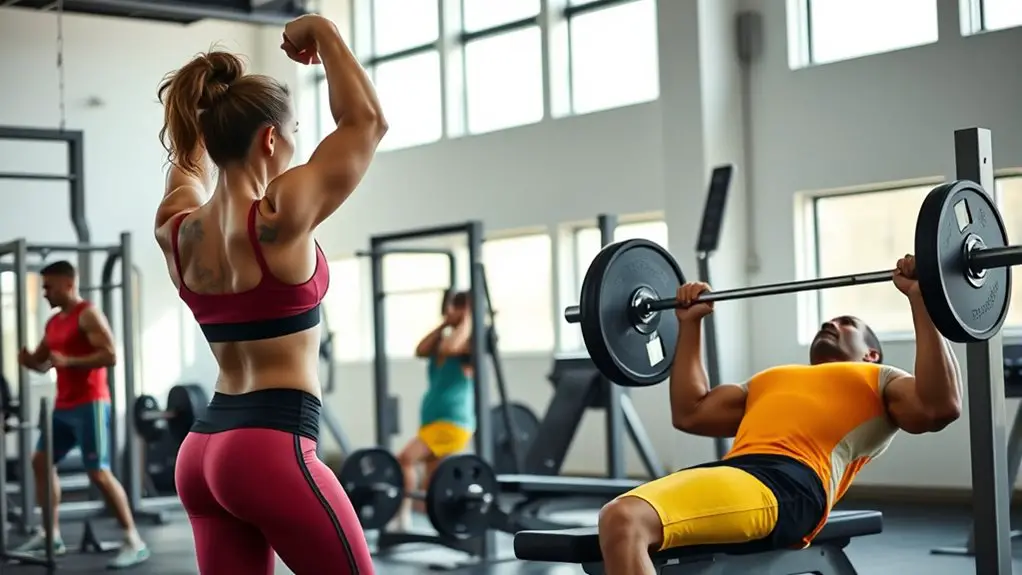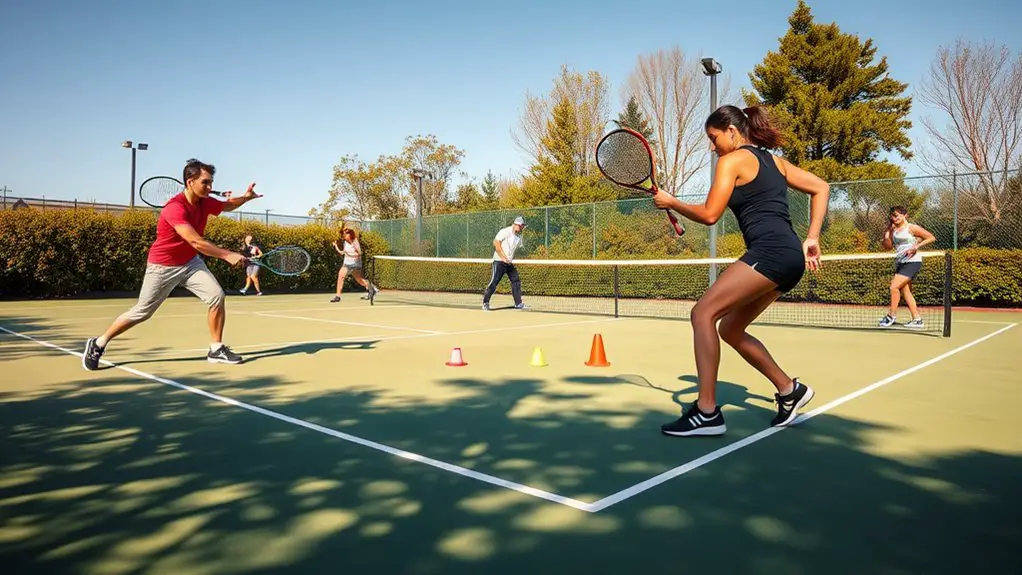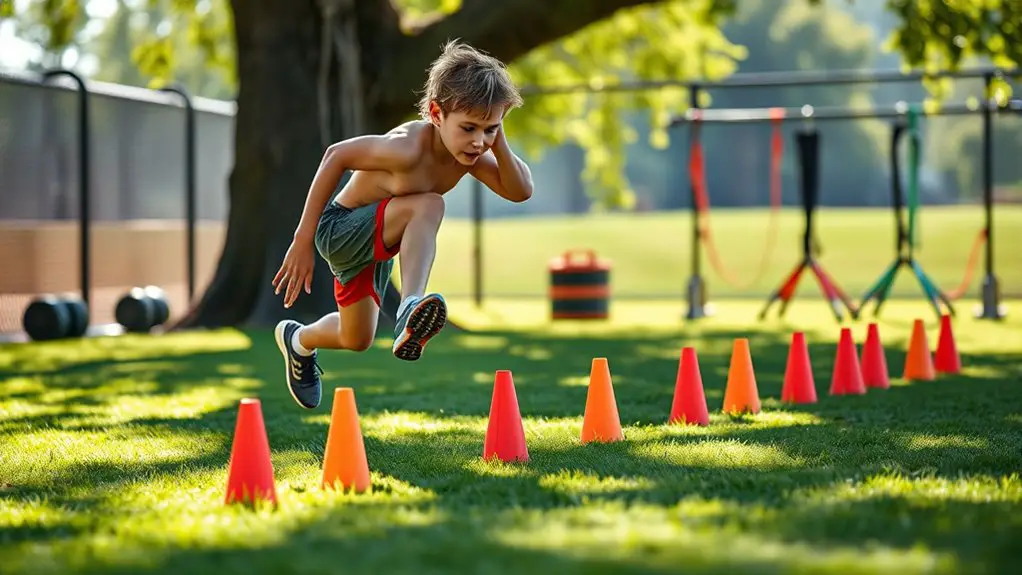To build full-body strength efficiently, focus on compound exercises like squats, deadlifts, and bench presses. Squats engage your entire lower body, while deadlifts target your posterior chain for power and stability. The bench press develops upper body strength, and the overhead press strengthens your shoulders and core. Don't forget about pull-ups for back and arm gains. By incorporating these exercises, you'll enhance performance and functionality. There's more to explore about optimizing your workout routine.
Squats: The Foundation of Lower Body Strength
When it comes to building lower body strength, squats are often considered the cornerstone of any effective workout routine. They engage multiple muscle groups, including your quadriceps, hamstrings, and glutes, making them essential for functional movement. You don't need fancy equipment; just your body weight can suffice, offering you the freedom to squat anywhere. As you progress, you can add weights to challenge yourself further. The beauty of squats lies in their versatility; you can experiment with variations like front squats or goblet squats to keep your workouts fresh. By mastering this fundamental exercise, you'll not only build strength but also enhance your athletic performance and mobility. Embrace the power of squats, and watch your lower body transform!
Deadlifts: Building Power and Stability
While squats lay the groundwork for lower body strength, deadlifts take your workout to the next level by targeting the posterior chain. This exercise engages your glutes, hamstrings, and back, building power and stability essential for everyday movements. When you lift from the ground, you're not just working muscles; you're developing functional strength that translates to real-life activities, giving you the freedom to move confidently.
Proper form is key—keep your back straight and engage your core to prevent injury. Start with lighter weights to master the technique, then gradually increase the load as you gain strength. Embrace the challenge of deadlifts, and you'll find yourself stronger, more balanced, and ready to tackle whatever life throws your way.
Bench Press: Upper Body Development
The bench press is a cornerstone exercise for anyone looking to develop upper body strength. It primarily targets your chest, shoulders, and triceps, giving you that powerful upper body look. When you press heavy weights, you not only build muscle but also enhance your confidence and boost your overall performance in other physical activities. You can perform it with a barbell or dumbbells, allowing for variations that suit your preference. Remember, maintaining proper form is essential to avoid injury and maximize gains. Incorporate the bench press into your routine, and you'll notice improvements in both strength and aesthetics. Embrace the freedom to push your limits, and watch your upper body transform as you progress!
Overhead Press: Strengthening Shoulders and Core
One of the most effective exercises for building shoulder strength and core stability is the overhead press. This compound movement challenges your shoulders, triceps, and core all at once. As you lift the weight overhead, you're not just working your upper body; you're also engaging your core to maintain balance and stability. It promotes functional strength, allowing you to perform everyday activities with ease. Plus, the overhead press encourages good posture, helping you stand taller and feel more confident. To get started, use a barbell or dumbbells, and remember to keep your feet shoulder-width apart. As you press the weight up, breathe out and embrace the freedom of movement that comes from building a strong foundation.
Pull-Ups: Enhancing Back and Arm Strength
If you want to build a strong upper body, pull-ups are an excellent choice. They engage your back, biceps, and shoulders, helping you develop functional strength that translates into everyday activities and sports. To perform a pull-up, grip the bar with palms facing away and pull your body upwards until your chin clears the bar. Don't rush; focus on controlled movements to maximize strength gains.
Incorporating pull-ups into your routine not only enhances your muscle tone but also boosts your confidence. You'll feel empowered as you conquer your own body weight. If you're new to pull-ups, don't worry! You can start with assisted variations or negatives to build up your strength. Embrace the challenge and enjoy the freedom that comes with newfound strength.
Lunges: Improving Balance and Coordination
While lunges may seem simple, they're incredibly effective for improving balance and coordination. When you step forward or backward into a lunge, you're engaging multiple muscle groups while also challenging your stability. This movement helps enhance your proprioception, making you more aware of your body in space.
Incorporating lunges into your routine can free up your movement, enabling you to navigate everyday tasks with ease. Whether you're hiking, dancing, or simply walking, better balance and coordination can boost your confidence and performance.
Start with bodyweight lunges and gradually add weights for more intensity. Remember, consistency is key. Soon, you'll notice how lunges not only strengthen your legs but also empower your overall physical freedom.
Rows: Developing Posture and Back Strength
Rows are a powerhouse movement for developing posture and back strength. When you engage in rowing exercises, whether with a barbell or resistance bands, you're not just targeting your back muscles; you're also reinforcing the foundation of your overall strength. Good posture isn't just about looking confident; it's key to feeling free and unrestricted in your movements. By incorporating rows into your routine, you'll strengthen your upper back, improve your alignment, and reduce the risk of injury. Plus, a strong back supports better performance in other activities, from lifting to everyday tasks. Embrace the freedom that comes from a strong, balanced body—your posture will thank you, and so will your future self.
Frequently Asked Questions
How Often Should I Perform These Compound Exercises?
You should aim to perform these compound exercises two to three times a week. Listen to your body, though; if you feel fatigued, it's okay to take a break and let yourself recover.
Can Beginners Safely Perform These Compound Exercises?
Yes, you can safely perform compound exercises as a beginner. Just start with lighter weights, focus on form, and gradually increase intensity. Listen to your body, and you'll build strength without risking injury. Enjoy the journey!
What Equipment Do I Need for These Exercises?
Ever thought about how little equipment you actually need for powerful workouts? Just a set of dumbbells, a barbell, and a sturdy bench can release your potential, giving you the freedom to build strength anywhere, anytime.
How Do I Prevent Injuries During These Exercises?
To prevent injuries, you should warm up properly, use correct form, start with lighter weights, and listen to your body. Don't push through pain; give yourself time to recover and adapt as needed.
What Is the Best Warm-Up Routine Before Starting?
Imagine a bird stretching its wings before flight. To warm up, you should do dynamic stretches, like arm circles and leg swings. This'll awaken your muscles, helping you move freely and prevent injuries during your workout.




